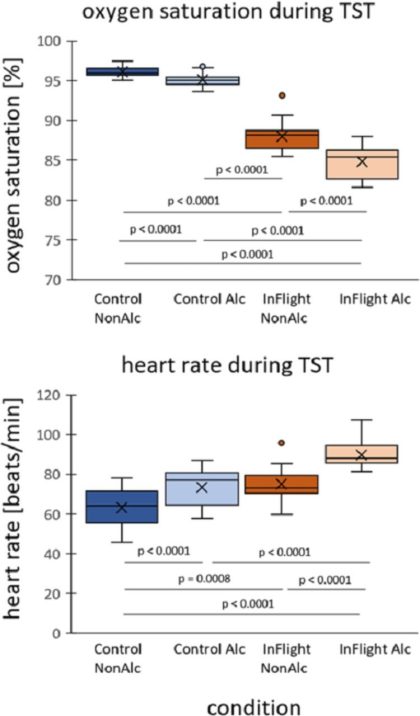Would you like wine with your meal, or oxygen saturation and a normal heart rate while you sleep?
The wishful thinking in some sensible, evidence-based health recommendations can bring a wistful tear to the eye.
The fact that the combination of alcohol and altitude is not great for your heart, for example, has about as much chance at achieving alcohol restrictions on aeroplanes as I have of being invited into the cockpit to fly one of the damn things.
After all, thanks to the diligent weekly collation of information about how terribly people behave on planes under the influence of alcohol (among other factors) by two comedians, sorry, researchers, Luke Heggie and Nick Cody, in their ongoing audio public health thesis known as Mid Flight Brawl, airlines have all the evidence they need to stop serving people booze if they were remotely tempted to do so.
But hey, let’s look at the science anyway.
German researchers hypothesised that since alcohol reduces REM sleep duration and increases heart rate, and hypobaric hypoxia also shortens REM and decreases oxygen saturation during sleep, leading to a compensatory increase in heart rate, the combination of booze and the reduced pressure of a flight cabin would make for a pretty unhealthy kip.
In their study, published in BMJ Thorax, they put 48 healthy people aged 18-40 through a two-night experiment at the Institute of Aerospace Medicine of the German Aerospace Centre in Cologne. Controls spent one night alcohol-free and one night having drunk alcohol in sea-level pressure conditions, while the inflight group did the same in hypobaric conditions.
They had a four-hour sleep window between midnight and 4am, during which polysomnography, SpO2 and heart rate were monitored continuously. In the booze condition they were given enough pure vodka to reach 0.06% blood alcohol concentration, the equivalent of two beers.
The results were robust. Frankly, a bit alarming.
Hypobaric hypoxia and alcohol had indeed “a supra-additive effect” on oxygen saturation and heart rate, such that the inflight alcohol group spent 95% of their sleep time clinically hypoxic.
Median oxygen saturation fell in this group well below the 90% threshold to 85%, their poor hearts compensating with a median rate of 88bpm, as shown in this figure.

“Together these results indicate that, even in young and healthy individuals, the combination of alcohol intake with sleeping under hypobaric conditions poses a considerable strain on the cardiac system and might lead to exacerbation of symptoms in patients with cardiac or pulmonary diseases,” the authors write, noting that CV symptoms are involved in 7% of inflight emergencies and cardiac arrests cause almost 60% of plane diversions.
REM sleep was also shortened, as expected, among other changes to sleep architecture.
The participants slept lying down, as if they were in business or first class. The authors point out that the ease of sleeping this way compared with upright means that sleep-deprived economy passengers are actually better off, heart-wise, than the special folk up front being plied with booze and getting horizontal.
Well, there’s some justice there at least.
Analysis found the hypobaric conditions contributed more to the changes than alcohol.
But, since “technical and economic constraints make it unlikely that an increase in cabin pressure will be implemented by airlines”, there should be more awareness of the role of alcohol. In fact, they conclude, “Our findings strongly suggest that the inflight consumption of alcoholic beverages should be restricted.”
Absolutely, and we say again, good luck with that.
Send cute little 50mL story tips to penny@medicalrepublic.com.au.


